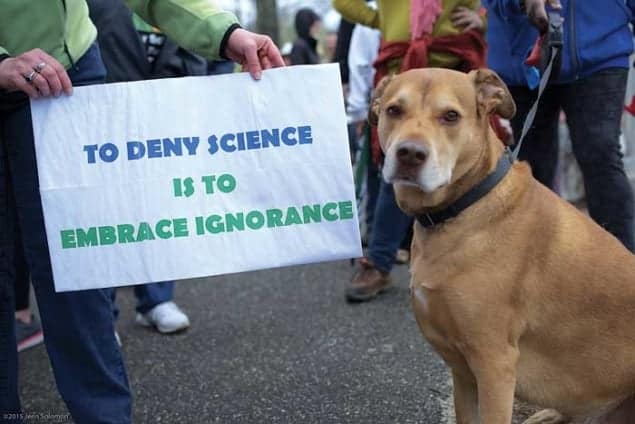Robert P Crease reveals his ambivalence about the recent marches for science – and why he went on one in the end

I didn’t expect so many dogs.
On 22 April I and a few hundred other people spent two hours slowly snaking along the three-mile perimeter road that circles Stony Brook University’s main campus. The event, which took place in intermittent rain, was one of the smallest of more than 600 “science marches” that day. It was nothing like the event on the mall in Washington, DC, which attracted some 50,000 people and eminent speakers, or the tens of thousands who took to the streets in New York City.
I chose the local event because I was ambivalent about the very idea of a “science march” and liked the fact that Stony Brook’s was informal, had no speakers, was not overwhelming and I could bring my dog. Dashiell, it turns out, got along well with the diverse pack of other canines there, many sporting clever signs such as “Dogs fur science” and “Save national labs!”.
Taking sides
My ambivalence reminded me of the reluctance that the German–American philosopher Hannah Arendt had about championing democracy. Arendt (1906–1975) was a Jew who fled Nazi Germany for France in 1933, wound up in a French internment camp, until finally making her way to the US in 1941. In the 1950s she became a writer known for books and essays on the origins of totalitarianism.
In one essay, “The eggs speak up” (1950), Arendt attacked the idea behind the self-justifying Stalinist slogan that the only way to “make an omelette” (get anything done) is to “break some eggs” (commit lesser injustices). But Arendt also wrote critically of ex-communists who championed democracy with the same fervour they’d previously had for communist ideology. “Democratic society as a living reality,” she warned, “is threatened at the very moment that democracy becomes a ‘cause’.”
Causes are things about which one can legitimately “take sides”. As she saw it, there was no alternative to democracy. Democracy, she thought, is what creates the free and open environment needed for genuine political actions – for individuals to act in concert to give birth to new kinds of social forces and institutions. Like the Higgs field that spawns mass, democracy is the environment in which causes can form and be advocated.
Arendt feared that turning democracy itself into a cause might spoil it, fostering an atmosphere of self-righteousness and even zealotry. You begin to evaluate every action not for whether it is good, but for whether it will promote democracy. If a good action might harm that cause, you may entertain the value of “lesser evils”, such as abridging basic freedoms.
Arendt’s remarks captured my own hesitation about the wisdom of marching for science. Science has no alternatives; alternative theories in science are not alternative theories to science. Science is inquiry; an open and imaginative way of exploring the structure and dynamics of the world. The atmosphere in which inquiry thrives is very different from authoritative leaders delivering inspirational speeches to crowds who march from one place to another to show their strength in numbers.
As it happens, on the very day that the science marchers gathered on the mall in Washington, DC, the National Math Festival was being held nearby in the city’s Convention Center. A day-long gala that promoted mathematics and its role in the world, the festival included 80 events with puzzles, music, art, origami, games and geometric sculpture assemblies. A festival that spreads information around in a community-enhancing and entertaining way is, I felt, a better way to promote the open and inquisitive spirit of inquiry than a march.
Yet at one point in “Eggs”, Arendt also observed that making a cause of democracy may be necessary in exceptional times involving “clear and present danger”. That was the other side of my ambivalence. The current US administration’s forthright refusal, I thought, to incorporate scientific findings into critical policy decisions affecting health, environment and energy issues surely counts. The administration is clearly trying to destroy the conditions that underlie inquiry itself, replacing it with certitudes provided by ideology and religion for the benefit of the wealthy and privileged. The rest of us are becoming the broken eggs.
Science, in short, was now cause-like. That’s what made me decide to march.
The critical point
Stony Brook’s event was not the only campus activity that day – there were sports, classes and a concert too. Many signs were bland and generic, some variant of “Support science!” Others were clever – “Remember polio? I don’t. Thanks, science!” – or esoteric, such as the one quoting the French public intellectual Pierre Bourdieu on the value of sociology. Still other signs were about vaccinations, bird-watching and gun violence. I had many unexpected conversations about science and politics, and overheard local gossip, snippets of news and reflections on why we were all doing this.
Nobody was watching our march. That made it feel intensely social, like a theatre performance in which everyone was an actor, spectator and critic all at once. We were consolidating and reinforcing our communal common sense in a way we never could have in a lab, at home or via e-mail. Most demonstrations are designed to get on television, to sway the opinions of nonparticipants. But we were simply celebrating what we did, and it made us feel a part of something larger than ourselves. Here and in hundreds of locations over the globe, the eggs were indeed speaking up.
- Enjoy the rest of the June 2017 issue of Physics World in our digital magazine or via the Physics World app for any iOS or Android smartphone or tablet. Membership of the Institute of Physics required



